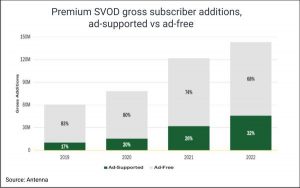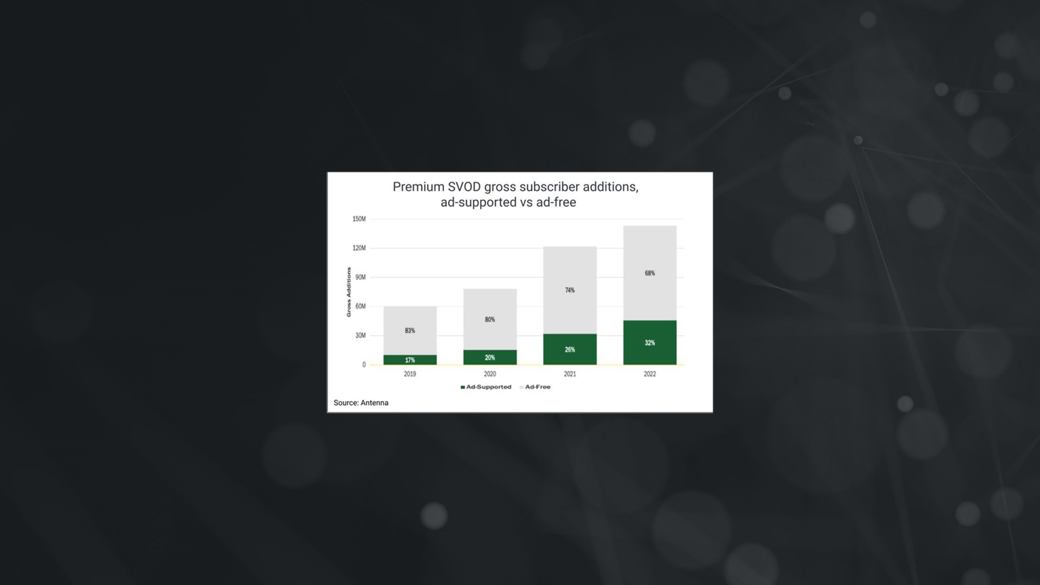STREAMING GROWTH: SVOD EDITION
According to the quarterly report from Antenna, 32% of subscriptions added to premium SVOD streaming services last year were to ad-supported plans, which is up from 20% in 2020. The four services that added ad-supported tiers recently are Peacock, Hulu, Paramount+, and Discovery; each of which has at least 43% of ad-supported subscriptions. “Furthermore, the proportion of new subscribers/gross adds selecting the ad-supported option is higher than the existing subscriber base for six of the seven premium streamers.” Another trend highlighted is the growth of subscriptions through third parties/distribution platforms such as Apple, Amazon, Roku, and Google as more than half of new subscriptions came through those platforms last year. (MediaPost: 3/28/23)
ARF’S TV-ACCESSIBLE HOUSEHOLDS
The Advertising Research Foundation is calling on the TV industry to stop using TV households as the basis for measurement of TV viewing and to start using TV-accessible households. TV households are defined as households with at least one TV set and TV-accessible households are defined as homes with broadband access that consume TV programming on devices through streaming services and vMPVDs. According to an ARF study, “about 5% of U.S. households don’t own a TV set. But about 80% of those households have broadband and stream TV programming.” Another interesting takeaway from the ARF study was that most major-brand TVs were more likely to be set up in shared spaces like the living room, media room, or dens, while less-expensive TVs were more likely to be in a bedroom. (NextTV: 3/27/23)
FREE, AD-SUPPORTED STREAMING TAKES OFF
Horowitz released its latest State of Media, Entertainment & Tech: Subscriptions 2023 study that found “nearly 7 in 10 (69%) of TV content viewers in the U.S. use free streaming services at least monthly.” There has been rapid growth in the use of free streaming which is “driven by the number and variety of free, ad-supported streaming TV (FAST) services.” Popular services include Peacock, Tubi, Pluto, and YouTube. The study also found that 33% of cord-cutters do not feel that they are saving as much money compared to 2019 when more than 50% of cord-cutters felt they were saving. “And already, 1 in 3 (30%) consumers indicate that they pay for at least one of their streaming services in combination with another service they have” such as bundling with another SVOD through a service like Amazon Prime. According to Horowitz’s Chief Revenue Officer and Insights & Strategy Lead, Adriana Waterston, this data points to opportunities for media companies and consumers as she says, “the adoption of AVOD/FAST services – and the concomitant increase in streaming ad revenue we can expect to see – will help offset revenue loss on the linear side, which is critical as programming costs continue to skyrocket.” (Horowitz: 3/28/23)
HOW VIDEO TRANSFORMED THE WORLD
The MoMA is hosting Signals: How Video Transformed the World, an exhibition running through July 8th, 2023. The exhibition highlights more than 70 media works and enables audiences to experience video across multiple formats as “video is everywhere today – on our phones and screens, defining new spaces and experiences, spreading memes, lies, fervor, and power.” Non-members can reserve a timed ticket at $25 per person (discounts for members and others). There is also a selection of videos from the exhibition online on the Signals Channel. (MoMA: 2023)

